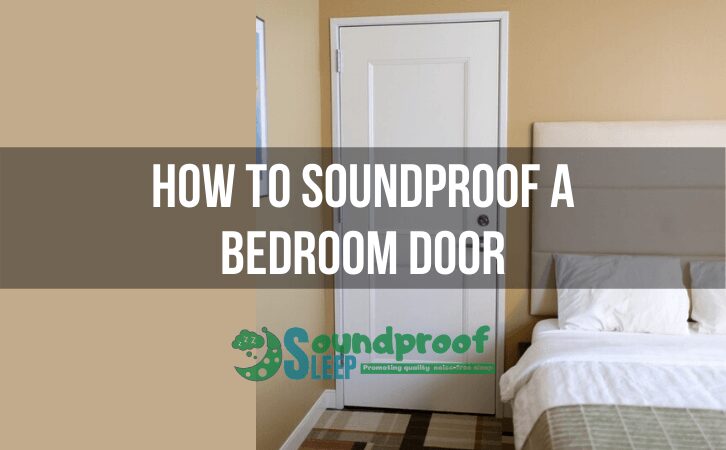Apart from a comfortable mattress. comfortable pillows, and a comfortable feel of sheets and bedding, a quiet room was ranked fifth by users in a poll by the National Sleep Foundation as one of the things that influence sleep in a bedroom. Soundproofing the bedroom is a sure way of dealing with noise. However, where do start?
Doors and windows are the weakest links that let in noise in a room. For doors, buying an acoustically rated/soundproof door is the best solution. However, these doors are crazy expensive. In this article, I will cover some methods you can follow to soundproof your bedroom door. Most of these methods are cheap and easy for you to undertake. Enjoy.
How to Soundproof a Bedroom Door
- Seal All The Gaps & Cracks Around The Door
- Seal the Gap Under The Door
- Add Mass to the Door
- Install Foam Tiles
- Place a Rug in The Entryway
[sta_anchor id=”seal-gaps-cracks-around-door”]1. Seal All The Gaps & Cracks Around The Door[/sta_anchor]
The first step when soundproofing a door is to seal gaps and cracks around the perimeter of the door.
Caulking is one of the ways you can seal cracks and gaps around the door.
First, turn off the lights in the bedroom, and leave lights in the hallway turned on. Identify and mark cracks that will let light in as these are potential culprits that also let in noise. Alternatively, you can switch off all the lights and ask your partner or friend to shine a flashlight around the door frame.
Once you’ve taken note of the cracks, use a good acoustic caulk to fill them up. When choosing a good acoustic caulk, choose one that will not crack open when dry, and can be painted over. The Green Glue Noiseproofing Sealant and Sashco Big Stretch Acrylic Latex Sealant are both good sealants you can choose to seal cracks. Also, while at it, you will require a caulking gun to squeeze caulk out. Consider getting a properly sized gun in-case you do not have it.
If the cracks around the door frame are too big, then an expanding gap filler will do the trick. As the names suggest, you just need to apply an expanding gap filler into the gap and watch as it expands to close the gap. Depending on the gap filler of your choice, read the instructions to make sure it is properly applied for the best results.
If your door has a gap between the frame and the door, neither caulking nor an expanding gap filler will do the trick.
Weatherstripping or adding soundproof rubber between the door and the door frame is the easiest and fastest way of solving this problem.
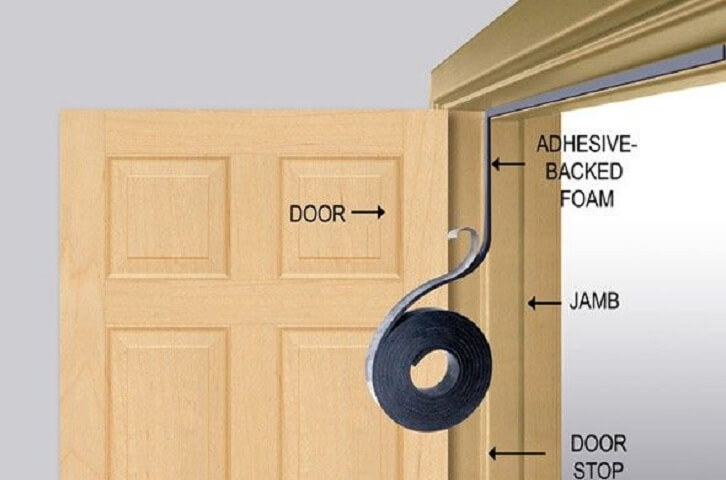
Weatherstripping tape is applied to the gap and seals it effectively. Alternatively, soundproof rubber can be used to cover the gap.
For a permanent and better solution of closing the gap between the frame and the door, consider installing a door gasket. Door gaskets are a bit more expensive but are effective compared to weatherstripping. Weatherstripping tape is also prone to falling apart over time. For a start, like me, you can use weatherstripping tape. However, with time, upgrade to a door gasket.
Door gaskets can either be simple weatherstripping gaskets or stop mount gaskets. Stop mount gaskets are better and provide a better seal. They usually have rubber attached to an aluminum and are mounted with screws on to the door frame. They are durable, provide a superior seal, and can be adjusted during and after installation.
[sta_anchor id=”seal-gap-under-door”]2. Seal the Gap Under The Door[/sta_anchor]
Door gaskets, weatherstripping tape, soundproofing rubber, and caulking are all applied to the sides and top of the door. However, how do you stop noise from coming through the bottom of the door?
A door sweep is what you need.
Many doors have a big gap below the door that will allow sound to leak into a room. To prevent this from happening, installing a door sweep offers a quick and fast solution.
The Suptikes Door Draft Stopper is so far our best door sweep. There are also other options such as this Weighted Door Draft Stopper can also work.
Automatic door sweeps or automatic door bottoms are also good options and have their advantages. They are installed beneath or on the back of the door. As the door closes, a spring mechanism pushes down the door sweep and creates a seal. The advantages of an automatic door seal are it does not drag along the floor, thus protecting the floor, and also preventing the door seal from wearing out faster.
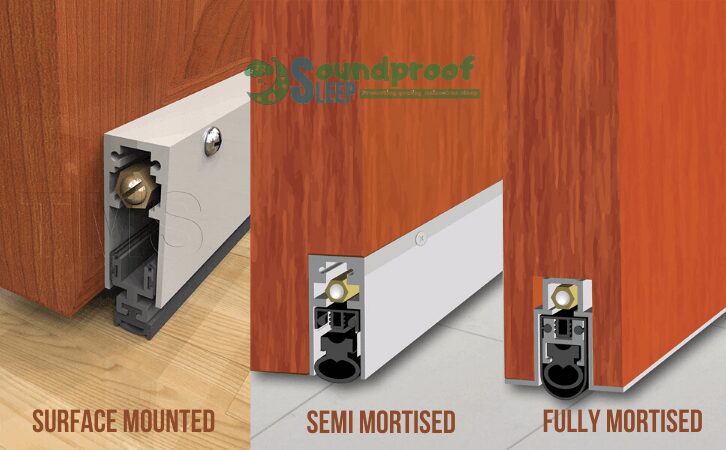
The TMS Automatic Door Bottom is a good option you can check out.
There are three ways you can install an automatic door bottom. It can be mounted directly at the back of the door. It can also semi mortised and screwed on the bottom of the door so that it is flush with the face of the door. Lastly, it can be fully mortised at the bottom of the door. A fully mortised design is good because it will not affect the overall appearance of the door.
Adding a door threshold is also another way of permanently sealing the bottom gap. Thresholds are a good alternative if the bottom gap between the door and the floor is big. Apart from blocking sound, a door threshold helps with energy conservation and keeping pests and other elements like dust out.
[sta_anchor id=”add-mass-to-door”]3. Add Mass to the Door[/sta_anchor]
Most bedroom or interior doors have a hollow core. This is why they are cost-effective, but in return, they do not block out sound or noise.
Adding extra mass over the door is a great way of blocking out noise.
Hanging a mass loaded vinyl (MLV) barrier is a sure and effective method of blocking out sound. The thicker the MLV you use on your door, the better the protection you get. First, measure the door and cut the MLV down to size. Once cut, use a good construction adhesive to attach the vinyl to the door.
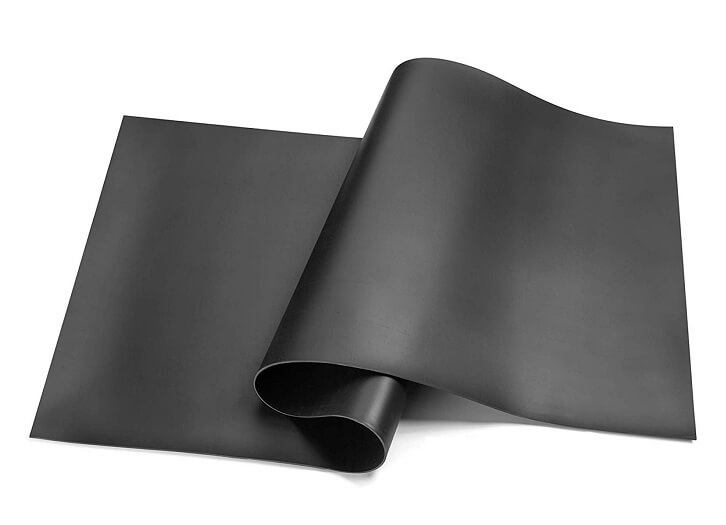
Both Soundsulate and TMS Mass Loaded Vinyl are good options you can try out.
Apart from MLV, you can also use a door soundproof blanket to add mass to the door and block out noise. Soundproof blankets can be hanged along the door to absorb sound. A soundproof blanket is a good option because they are easy to install, and you can also pull them down at any time.
The Audimute Sound Absorption Sheet Sound is a good pick if you are looking for a soundproof blanket. They are super easy to install and come with anchors and screws to hang them. They are a good choice for apartments and rentals where a permanent option like mass loaded vinyl is not possible.
[sta_anchor id=”install-foam-tiles”]4. Install Acoustic Tiles/Panels[/sta_anchor]
If mass loaded vinyl or soundproof blankets are too expensive, then you might want to check out acoustic tiles. Acoustic tiles come in a range of different materials. Foam is the most popular type, but solid wood exists too.
Acoustic foam panels or tiles are mounted on the front of the door, and their work is to absorb sound or noise before it enters the bedroom. They can be fitted together and nailed or screwed to the door or use a construction adhesive to avoid damaging the door.
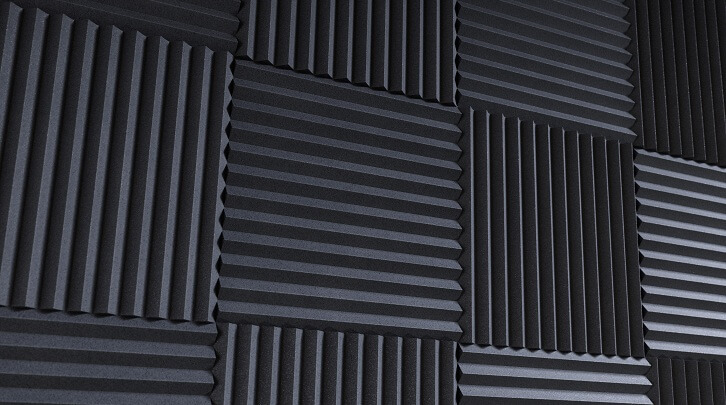
Just like mass loaded vinyl (MLV), acoustic foam panels should properly cover the door to be effective. Acoustic foam tiles come in different sizes, patterns, and colors. You can get creative in your design or choose a color that matches your home’s paint. Acoustic foam panels also come in different noise-blocking levels. Choose the highest noise-reduction level for better sound protection.
[sta_anchor id=”place-a-rug-in-door-way”]5. Place a Rug in The Entryway[/sta_anchor]
A rag is an optional choice you can choose to place near the door opening.
As sound travels along the hallway or into the room, it bounces off tiles or wood floor into the room. A rag limits noise and sound entering a room by dampening or absorbing the sound.
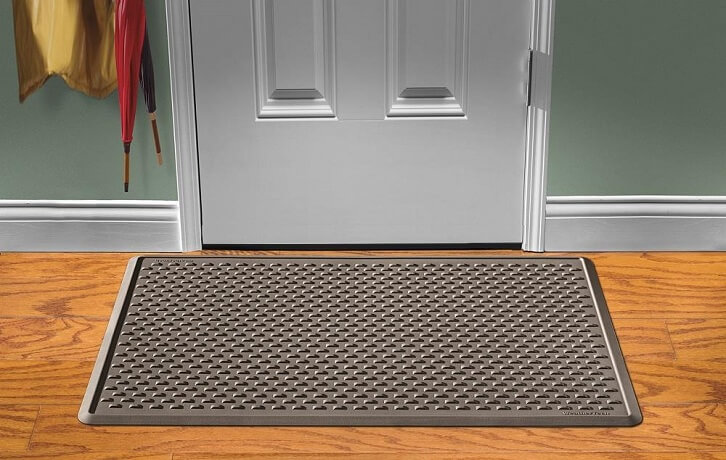
Most door rags will do the trick, but heavy ones are good at absorbing sound.
Adding a door is not an effective method of soundproofing a door. However, it does help if you are looking to block out even the tiniest of sounds coming through the door.
Wrapping Up
Soundproofing a bedroom door should be easy if you follow the pointers outlined above. The materials needed as very cheap, and you can easily work on the door without professional help. I hope that the information above is easy to understand even for those without technical knowledge.
Do you have any questions, clarifications, or suggestions?
Comment below, and I’ll be happy to assist where I can.

